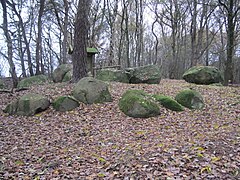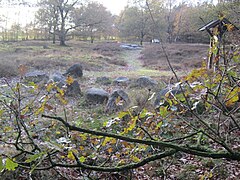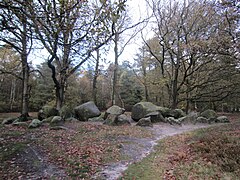Hümmling megalithic burial road
| Hümmling megalithic burial road | ||
|---|---|---|
|
|
||
| Coordinates | 52 ° 46 '53.4 " N , 7 ° 30' 44.3" E | |
| place | Groß Berßen to Hüven , Lower Saxony , Germany | |
| Emergence | 3500 to 2800 BC Chr. | |
| Sprockhoff no. | 856-861 | |
The six better preserved megalithic systems on the Hümmling Hünengräberstrasse are located on both sides of the K 138 road from Groß Berßen to Hüven on the Hümmling in Emsland in Lower Saxony . The large stone graves, some of which are located in the heather of the 14 hectare “ Holschkenfehn ” nature reserve, bear the Sprockhoff number. 856–861 and have been preserved to varying degrees.
The megalithic complex from the Neolithic was created by the funnel beaker culture (TBK) between 3500 and 2800 BC. Built in BC. Neolithic monuments are an expression of the culture and ideology of Neolithic societies. Their origin and function are considered to be the hallmarks of social development. These large stone graves were first mentioned in a travelogue from 1825. Even then, individual systems were destroyed. Systematic excavations took place mainly in 1955/1956.
description
- The westernmost chamber (Sprockhoff no. 856 - the "large stone grave in Ipeken" I - fir forest) is located immediately south of the road in an incomplete oval enclosure, of which 24 stones have been preserved. Almost only the capstones of the chamber can be seen. It used to be ten. Today seven are complete, an eighth has been preserved in fragments.
- For the system Sprockhoff no. 857 about 200 meters further east, also south of the road, is grave No. II
See main article Great stone grave in Ipeken
- On the same side of the street, after another 500 meters, you come across two stone chambers. From the severely disturbed western complex Groß-Berßen IV (Sprockhoff No. 858 - Groß Berßen IV) only three cover stones and two bearing stones are in the remains of the hill.
- Hune grave road on the Hümmling
- The eastern one is better preserved (Sprockhoff No. 859 - Groß Berßen VI). The former five capstones carried In situ is the western and one of the three middle capstones. Of the remaining capstones, some of which were broken, one of the drilled holes at the east end, which was rolled off, shows signs of an explosion that was no longer carried out. The system already served as a model for the coat of arms of the Aschendorf-Hümmling district . Since 1981 the symbol has been part of the coat of arms of the district of Emsland, the successor of the district of Aschendorf-Hümmling. This is why the tomb is also known as the “heraldic grave”.
- For the system Sprockhoff no. 860, which is a little off the road on the north side
See main article Royal Tomb of Groß Berßen
The reconstructed one is within sight, a little further to the east and closer to the road
- Plant Groß-Berßen VII, Sprockhoff no. 861. There is a chamber with five capstones in the oval hill. Inside you can see the restored intermediate masonry and the floor paving. The entrance area does not correspond to the original condition.
Heinrich Bödiker provided an initial detailed description of the facilities as early as 1825. Reports from the 19th and 20th centuries made it clear that the facilities were already destroyed on a large scale between 1750 and 1800. As recently as the middle of the 20th century, wild digs were being carried out at several monuments. In 1955, under the direction of Elisabeth Schlicht, extensive renovations and excavations were undertaken in the course of the road expansion. This resulted in a complete examination of the hill and stone chamber Sprockhoff no. 861. The construction of the eight meter long stone chamber with six bearing stones each on the northern long side and the already badly damaged southern long side and the two keystones could be reconstructed. The pavement, the access and parts of the intermediate masonry were still preserved. The former stone border of the hill could not be determined. Grave goods could still be recovered, especially under the capstones that had fallen into the chamber. In addition to two striking stones, the remains of a small copper disc and a roughly slammed flint ax, 22 cross-edged arrowheads were found. The ceramic shards, from which 330 vessels could be reconstructed, had the largest share. It is mainly about bottle and bowl-like shapes and decorated funnel cups. E. Schlicht recognized three different style groups by the shape and decoration.
See also
- Nordic megalithic architecture
- The facilities are located on the street of the megalithic culture
- Construction crew theory
literature
- Anette Bußmann : Stone Age witnesses. Travel to the prehistory of northwest Germany. Isensee Verlag, Oldenburg 2009, ISBN 978-3-89995-619-1 , pp. 67-69.
- Mamoun Fansa : large stone graves between Weser and Ems. Isensee Verlag, Oldenburg 1992, ISBN 3-89442-118-5 , pp. 60-63.
- Ernst Sprockhoff : Atlas of the megalithic tombs Germany. Part 3: Lower Saxony - Westphalia. Rudolf Habelt Verlag, Bonn 1975, ISBN 3-7749-1326-9 , pp. 101-103.
Web links
- Mystical stone realm without borders (PDF file; 40 kB)
Individual evidence
- ↑ J. Müller In: Varia neolithica VI 2009 p. 15






